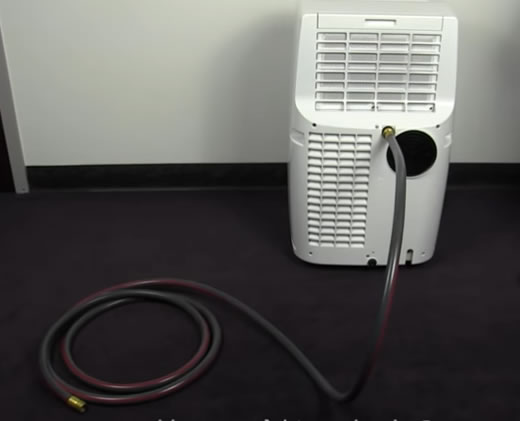How Portable Air Conditioners Evaporate Water
Many people know how the air is cooled by refrigeration using a compressed gas, but how does a portable air conditioner evaporate water and where does it go?
This may be something that is quite likely rather low on your list of ″things to find out in life. ″
However, wondering how an air conditioner, especially a portable unit, cools and dries the air is only part of the conundrum facing those with an interest and enough curiosity to want to know more.
 A questioning mind can turn its attention on a portable air conditioner and wonder about the internal workings of the unit, especially where the water that it extracts from the air goes and how it is dealt with!
A questioning mind can turn its attention on a portable air conditioner and wonder about the internal workings of the unit, especially where the water that it extracts from the air goes and how it is dealt with!
The Internal Mechanics of an Air Conditioner
Inside any air conditioning unit, whether it is a central air system, a mini-split AC, window AC or portable air conditioner, there is a mechanical process that is in many ways very similar to that found in a domestic refrigerator, just on a larger scale.
To paint a picture that is easy to visualize, a fridge has a motor at the base in back of the unit that is actually a compressor.
The Compressor
This component has the job of compressing a special gas that flows through inside a latticework of tubes into a liquid.
When compressed, the now liquid refrigerant cools dramatically.
The Evaporator Coils
That now chilled refrigerant flows through the tubes, known as evaporator coils, chilling them in turn.
Air from the space to be cooled is drawn into the unit and is chilled as it passes across those coils. Moisture in the air condenses on the cold coils.
Here is how that happens:
The heat from the once warm air is transferred to the refrigerant in the coils, which is warmed and returns to its gaseous state. The gas returns to the compressor to be re-compressed into a cold liquid again and the cycle repeats.
Here is what happens to the moisture that was condensed on the coils:
Traditional air conditioners have a simple way of dealing with the condensed moisture. Some of the moisture is re-evaporated by the heat produced by the compressor motor and that hot, moist air is expelled from the unit through a duct to the outside.
However, not all of the moisture is removed in this way. The remaining moisture inside the unit forms large droplets of water that simply drips down into a catchment vessel or water tank located at the base of the unit.
The tank needs to be emptied periodically to prevent it becoming full and then overflowing, making a mess on the floor. Most AC units have a fail-safe sensor that auto-shuts off the unit just before the tank reaches a certain level to prevent spillage.
Self-Evaporating Air Conditioners
There is another way of dealing with condensate produced inside air conditioning units, particularly portable units that have no fixed duct pipe that can drain excess water outside like a window or mini-split unit does.
Some of the newer fully self evaporating portable air conditioners on the market now feature a function that re-evaporates the condensed moisture and recycles it in the cooling process to reduce power consumption while increasing operational economy and efficiency.
Mini-Split Air Conditioners
There is a difference between portable, free standing air conditioners and fixed mini-split units in the way that air moisture is dealt with.
Mini-split AC units divide the cooling process between two separate units.
Indoors, the air handling unit draws warm air in where it is pumped through a duct to the outside unit, which contains the compressor and evaporator coils.
In the outside unit, the refrigeration process occurs. This is where the refrigerant gas is compressed into a liquid, cooling the evaporator coils over which the warm air is passed, chilling it and condensing the moisture present.
The chilled air is pumped back into the indoor unit where the now chilled and dried air is pumped into the room. The cycle continues until the room reaches a temperature set by the thermostat.
The excess moisture is exhausted out from the outdoor unit into the atmosphere.
Conclusion
While different air conditioner configurations deal with the moisture in different locations, the end result is much the same.
The excess moisture taken from the air in the room being cooled is both dispersed into the atmosphere outside via ducts or directly from an outside unit or excess condensed water is collected in a conveniently placed tank in the case of portable air conditioning units.
Posted: May 13, 2021
[Back to Top]